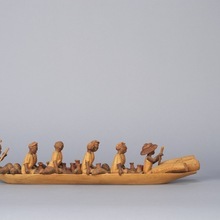Thorn Carving
MOA: University of British Columbia
3326/33
Thorn carving depicting a canoe full of people and goods. Ten figures are shown seated in the canoe. At the prow are a few large bundles and a person wearing a large hat paddling. Through the middle of the canoe are people seated in pairs with small jars and bundles around them. At the stern another person is paddling.
-
History Of Use
Thorn carvings are miniatures depicting a variety of scenes from Nigerian life. The carvings first began to be made circa 1930. The thorns vary in size; they can be as large as 12.7 cm long and 9.6 cm wide. The thorn wood is comparatively soft and easy to carve; they are traditionally carved by men.
-
Narrative
Most of the Nigerian objects in the Lieber collection were assumed to have been collected while Jack Lieber was living in Nigeria, 1965-1970. However one of the thorn carvings was made after 1971, so the dates are uncertain.
-
Cultural Context
craft; tourist art
-
Specific Techniques
The light yellow-brown thorn and the dark brown thorn come from the ata tree; the light red-brown thorn comes from egun trees. The parts are glued together with viscous paste made that was made from rice cooked with water.
- Type of Item carving
- Culture Yoruba
- Material atum thorn, egun thorn, adhesive, wood
- Measurements height 7.2 cm, width 34.5 cm, depth 9.0 cm (overall)
- Previous Owner Jack Lieber, Iris Lieber
- Received from Iris Lieber
- Made in Ibadan
- Creation Date during 1970
- Ownership Date before 2015, before June 18, 2018
- Acquisition Date on June 18, 2018
- Item Classes carvings & sculpture
- Condition fair
- Accession Number 3326/0033

